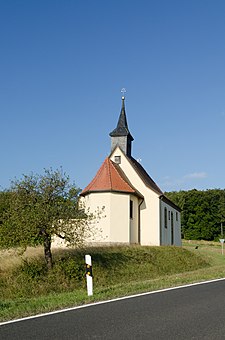Holy Cross Chapel (Sulzthal)
The Holy Cross Chapel is located in Sulzthal , a market in the Lower Franconian district of Bad Kissingen .
The chapel is one of the architectural monuments of Sulzthal and is registered under the number D-6-72-155-43 in the Bavarian list of monuments .
history
The first known documentary evidence of the Holy Cross Chapel dates from May 16, 1451. On this day, the papal legate for Germany, Cardinal Nikolaus , granted a hundred-day indulgence in connection with his visit to the chapel on September 14, 1451 . Further indulgences are known of August 28, 1787, March 26, 1794, July 6, 1801, July 10, 1818, April 16, 1847, November 17, 1854, April 29, 1873, January 13, 1876 and 1891.
According to legend, a spring with healing water should have sprung up at the location of the Holy Cross Chapel during a rest of St. Kilian zum Kreuzberg ; a rose bush had grown at the edge of the spring. The “Holy Cross Chapel from the Rosenbusch” was built here.
The Holy Cross Chapel developed into a popular destination for pilgrimages, which only ended with the Thirty Years' War . The absence of pilgrims after the war is said to be one of the reasons for the drying up of the spring.
In 1711 the chapel was enlarged, giving the chapel its present form. In 1730 the two side altars Beatae Mariae Virgini and Saint Sebastian were created . The cross in the chapel was also created in 1730 by the sculptor Gohorski. Inside the chapel houses the statue of St. Cyriacus . The picture of St. Anthony in the chapel was donated by a gout patient.
The first known evidence of a hermitage located next to the Holy Cross Chapel can be found in 1740 , whose inhabitants at that time looked after the chapel for several decades.
After a cattle epidemic in nearby Wittershausen (today part of Oberthulba ), the Holy Cross Chapel became the destination of pilgrimages by the inhabitants of Wittershausen.
Until the secularization at the beginning of the 19th century, when the chapel went to the Sulzthal community in 1804, services were held at the chapel twice a week. A cattle epidemic in 1796 led to petition processions to the chapel and subsequently to the establishment of a non-working day on "Sebastini" (January 20) in Sulzthal. Until 1964 and from 1977 on, on May 3, the day the cross was found , and on September 14, the day of the exaltation of the cross , solemn processions to the chapel were held; in the meantime they have been replaced by simple processions on Sundays. The procession on May 3rd led to the wayside shrine on Schweinfurter Weg and to the wayside shrine in Zent at the junction to Dürren First; The latter was dismantled during the land consolidation and put aside and disappeared a short time later.
With the secularization, the electoral Bavarian plan arose to let the Holy Cross Chapel go down. The property and goods of the chapel were to go to the Sulzthal parish church ; The services that had been read in the chapel up to that point were also to be moved to the parish church. This project met with resistance from the Sulzthal population, who offered in vain to keep the chapel and the services there at their own expense. The government commissioner, who experienced the bitter resistance of the Sulzthaler at the planned auction of the chapel, successfully offered them to auction the chapel for 30 guilders . As part of its reopening on November 14, 1810, the chapel underwent extensive renovation work.
In 1897 the Sulzthal painter Michel Schmitt renovated the Holy Cross Chapel and made the ceiling painting ; Station pictures and new chairs were also installed. In 1923 the chapel was given a new plaster by the miller Hermann Eberlein.
In gratitude that the Sulzthaler were able to prevent the incorporation of the Sulzthaler district including the Holy Cross Chapel into the Hammelburg military training area in 1951 , the chapel received new windows and doors as well as a new external plaster. Half of the costs of 2,200 DM were borne by the farmers in the Sulzthal population.
In 1960, due to the increasing number of break-ins, all valuable items from the Holy Cross Chapel came to the parish church. Another robbery in the chapel took place between February 17 and 20, 1969; further break-ins were unsuccessful.
Between 1987 and 1991 the market in Sulzthal underwent an extensive general renovation, the cost of which was covered by substantial own funds of the market as well as by private donations from the Sulzthal population.
literature
- Georg Dehio : Handbuch der Deutschen Kunstdenkmäler: Handbuch der Deutschen Kunstdenkmäler, Bavaria I: Franconia: The administrative districts of Upper Franconia, Middle Franconia and Lower Franconia: BD I , Deutscher Kunstverlag Munich Berlin, 2nd, revised and supplemented edition, 1999, p. 1013
- Churches, chapels, wayside shrines: Witnesses of religious life , in: Marktgemeinde Sulzthal: 1050 years Sulzthal - Historical Village Festival - Anniversary publication , 2003, pp. 35–37
Web links
Individual evidence
- ↑ Wittershausen website ( Memento from December 25, 2013 in the Internet Archive )
Coordinates: 50 ° 7 '25 " N , 10 ° 3' 5.4" E
